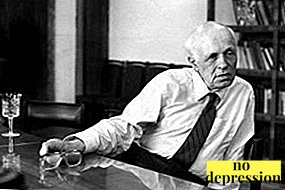How do psychologists define phlegmatic? Will the ordinary person be able to identify the phlegmatic person after a little communication with the latter?
Phlegmatic is difficult not to recognizeif you know the typical traits of this type of temperament. Characteristic of phlegmatic persons: men and women will be considered in the article.
Scientific definition of the term

Psychologists, physiologists and other representatives of the scientific world are referred to as phlegmatic subjects with inert type of nervous system, providing a person with a balanced character, a slow reaction to irritants and a calm mood under any circumstances.
In short, such a person has a low level of mental activity, so he is not prone to external manifestation of emotions and active facial expressions even in emergency situations.
What is phlegmatism?
Impassibility seeming to others with a more dynamic mentality of callousness and indifference.
Under the definition of phlegmatism falls and weakly active behavior, combined with drowsiness, general lethargy, covering a person most of the period of his wakefulness.
The concept of phlegmatization
The term is associated with chemical and other industries where processes require the use of substances capable of minimizing the risk of activation of explosive substances. Thus, phlegmatization should be understood. methods of action to suppress the violent reaction.
Who are phlegmatic? Find out from the video:
Psychological picture

Calm mimicry and restraint phlegmatic, almost never aggression, often annoying others, taking this behavior for arrogance, callousness and even underdevelopment.
But the latter is true only in cases where a person does have deviations in intellectual development.
Interested in achieving the goal of phlegmatic can be compared with fate fate - Getting the desired result is only a matter of time.
Since such a person will fully concentrate on the object and will move in the intended direction for an arbitrarily long time, with no less interest and enthusiasm.
True, from the side of emotional “burning” no one will see: before the eyes of others there will be the same subject, “greedy” for emotions and an abundance of unnecessary gestures.
Characteristic features of phlegmatic are:
- Equilibrium. Impression from the side: in front of you is a person whose heart is not able to tremble in response to any stimulus with a plus or minus sign. And only a close friend of the phlegmatic person, endowed with empathy and insight, is able to determine from the face of the latter whether he really is calm or is eaten from the inside by some kind of anxiety.
 Responsibility and steadfastness. Agreeing to perform a specific task, he will not change the expected behavior from him under the influence of others, emotions, beyond the limits of his understanding of intuitive feeling.
Responsibility and steadfastness. Agreeing to perform a specific task, he will not change the expected behavior from him under the influence of others, emotions, beyond the limits of his understanding of intuitive feeling.- Realistic attitude to the world and yourself. Phlegmatic phantasmals are alien to them, they are materialists and are not inclined to exaggerate their own or someone else's capabilities. Therefore, they rarely find themselves in creative professions. But it is difficult to find the best performers than phlegmatic, if there are tasks where initiative and creativity are not required.
Confidence in their abilities simplifies career advancement: a person chooses an activity that he likes and knows about his abilities to perform it.
- Straightness. The meager reserves of illusions, the natural craving for a journey along straight and deliberate roads, do not allow phlegmatic people to miserly in conversations on any topic with anyone. Therefore, most of them sincerely give the truth to the face, unaware that it can be dangerous, for example, for a career or relationship. But if you have known each other for a long time, in most cases this is not even offensive, but is perceived as constructive criticism. And all because it comes from a calm person, not seen in the love of demagoguery and the humiliation of others, and more like instructions for correcting the situation.
 Kindly. Raising elephants from flies is not about phlegmatic people. The slow response to the stimulus allows it to burn out inside all the offenses before emotions can be reasonably thrown out in front of others. Because of this, there are many calm people among those with heart attacks who are not seen in the love of loud conflicts.
Kindly. Raising elephants from flies is not about phlegmatic people. The slow response to the stimulus allows it to burn out inside all the offenses before emotions can be reasonably thrown out in front of others. Because of this, there are many calm people among those with heart attacks who are not seen in the love of loud conflicts.- Do not conflict. They do not need a reason to reset the negative on others, they do not seek to dominate or moral repression of another person.
Temperament features:
- In conversations, the low-expression intonation prevails, the mimic accompaniment is minimal.
- Mood is steady.
- In the actions, especially those associated with the new activity, there is some inhibition.
- Decisions are always justified, spontaneous actions are alien.
- Inert behavior in relationships and work. Turbulent instructions are executed immaculately. To assimilate the new regulations, more time is required than the rest of the staff.
Character
Phlegmatic is easy to identify even for a specialist in psychology.

People with this temperament are different:
- livableness (favorable prognosis in friendship, cooperation or marriage with a person of any temperament, if the partner is a socially adequate and law-abiding person);
- loyalty;
- lack of desire to take initiative in any issues;
- the ability to listen;
- love of order;
- sacrifice.
Typical features of a male phlegmatic person:
- silent;
- balanced;
- calm;
- concentrated;
- stingy on the expression of emotions in communicating with any people;
- hardworking;
- preferring quiet work, where the result depends on dedication and consistency.
Typical features of a woman phlegmatic:
- not prone to frivolous actions;
- rarely or never hysteria;
- hardworking;
- speaks slowly, in a low voice;
- in the wardrobe she prefers things in pastel colors, strict or even not pronounced style.
For young parents who have no pedagogical experience, the firstborn phlegmatic is a gift of fate in all respects, if they do not abuse the behavioral characteristics of their baby.
He is not picky about the abundance of attention from adults, can long be enthusiastically study the subject of interest. Matured child everything has an opinion that will only be shared with those who deserve trust.

The slowness in doing any work may be cause displeasure on the part of adults, overt choleric or sanguine.
But if they realize how thoughtful their child is to each type of activity - from tying shoelaces to solving complex tasks, then they will be able to raise a person who is able to achieve any goals.
Tips for raising a child phlegmatic:
Description of qualities
What does a stolid person mean? Restraint and slowness - congenital features of a person with a phlegmatic temperament.
Constant attempts to force such a person to move in an uncharacteristic rhythm of life become the cause of the development of neurosis.
He is not lazy, as it may seem from the outside, he just has a special structure of the nervous system.
What kind of work is suitable?
Best deal with the duties of a physician (the most appropriate specialty is a therapist, a gastroenterologist, a cardiologist, a psychologist / psychotherapist), an accountant, an employee of the personnel department, a researcher.
Temperament phlegmatic and choice of profession:
Features, Pros and Cons
Features include:
 equilibrium;
equilibrium;- peacefulness;
- a responsibility;
- constancy;
- mean gesticulation.
Virtues:
- reliability;
- realism in judgment and perception;
- not conflict;
- patience;
- cold blood.
disadvantages:
- lack of initiative;
- slowness;
- excessive harshness in the statements because of a misunderstanding that directness can hurt hurt;
- isolation;
- stupidity.
Definition and characterization
Choleric and phlegmatic in one person. If a person manifests himself sometimes as a choleric person, and sometimes as a phlegmatic person, then this may indicate some mental disorders, and perhaps just fatigue.
Phlegmatic choleric. These are two antipodes, capable of consistently conflicting with each other or forming an ideal union in which the shortcomings of one will be compensated by the merits of the other.

The main thing in such relationships is the desire to listen and the understanding that the partner does not do something in spite, but simply works differently and has his own, reasonable view of things.
Phlegmatic introvert. Most phlegmatic introverts.
But if the phlegmatic-extrovert appears on the horizon, you will not find a better friend and more reliable assistant performer in any enterprises.
How to communicate?
As with any other person. Basic principles:
- Respect.
- Listen.
- Let's understand that appreciate his skills, abilities, skills.
How to become phlegmatic?
Understanding Zen.
If seriously, then choleric or sanguine persons would be nice to learn from phlegmatic thoughtful attitude to solving problems, and melancholic would benefit from a less painful reaction to imaginary or real sideways views of outsiders.
Famous and famous phlegmatic persons:
 Kant (German philosopher);
Kant (German philosopher);- Kutuzov (famous commander);
- Galileo (the scientist);
- Churchill (politician);
- Sakharov (scientist).
Pure phlegmatic, as, by the way, sanguine, choleric, melancholic, are found in exceptional cases.
But the knowledge of the characteristics of each temperament facilitates the communication of cultured people seeking contact points and the opportunity to build a constructive dialogue in any situation.
Strengths and weaknesses of phlegmatic, and how to communicate with him:

 Responsibility and steadfastness. Agreeing to perform a specific task, he will not change the expected behavior from him under the influence of others, emotions, beyond the limits of his understanding of intuitive feeling.
Responsibility and steadfastness. Agreeing to perform a specific task, he will not change the expected behavior from him under the influence of others, emotions, beyond the limits of his understanding of intuitive feeling. Kindly. Raising elephants from flies is not about phlegmatic people. The slow response to the stimulus allows it to burn out inside all the offenses before emotions can be reasonably thrown out in front of others. Because of this, there are many calm people among those with heart attacks who are not seen in the love of loud conflicts.
Kindly. Raising elephants from flies is not about phlegmatic people. The slow response to the stimulus allows it to burn out inside all the offenses before emotions can be reasonably thrown out in front of others. Because of this, there are many calm people among those with heart attacks who are not seen in the love of loud conflicts. equilibrium;
equilibrium; Kant (German philosopher);
Kant (German philosopher);

